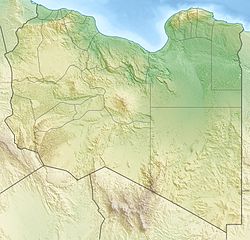The Acacus Sandstone is a geologic formation in the Ghat District, southwestern Libya. The unit preserves fossils dating back to the Llandovery epoch of the early Silurian period.[1]
| Acacus Sandstone | |
|---|---|
| Stratigraphic range: Llandovery ~ | |
| Type | Formation |
| Lithology | |
| Primary | Sandstone |
| Other | Shale |
| Location | |
| Coordinates | 25°00′N 10°12′E / 25.0°N 10.2°E |
| Approximate paleocoordinates | 77°30′S 116°54′E / 77.5°S 116.9°E |
| Region | Ghat District |
| Country | |
| Extent | Libyan Desert |
Fossil content
editThe formation has provided the following fossils:[1][2]
Trilobites
editEurypterids
editInvertebrates
editIchnofossils
editSee also
edit- Fish Bed Formation, Silurian fossiliferous formations of Scotland
- Lipeón Formation, Silurian fossiliferous unit of Bolivia
- Soom Shale, Late Ordovician Lagerstätte of South Africa
- Bertie Formation, Silurian Lagerstätte of Ontario and New York
- Andean-Saharan glaciation
References
edit- ^ a b Acacus Sandstone at Fossilworks.org
- ^ Plotnick, 1999
Bibliography
edit- Plotnick, R. E (1999), Habitat of Llandoverian-Lochkovian eurypterids, in A. J. Boucot, J. D. Lawson (eds.), Paleocommunities - a case study from the Silurian and Lower Devonian, pp. 106–136
